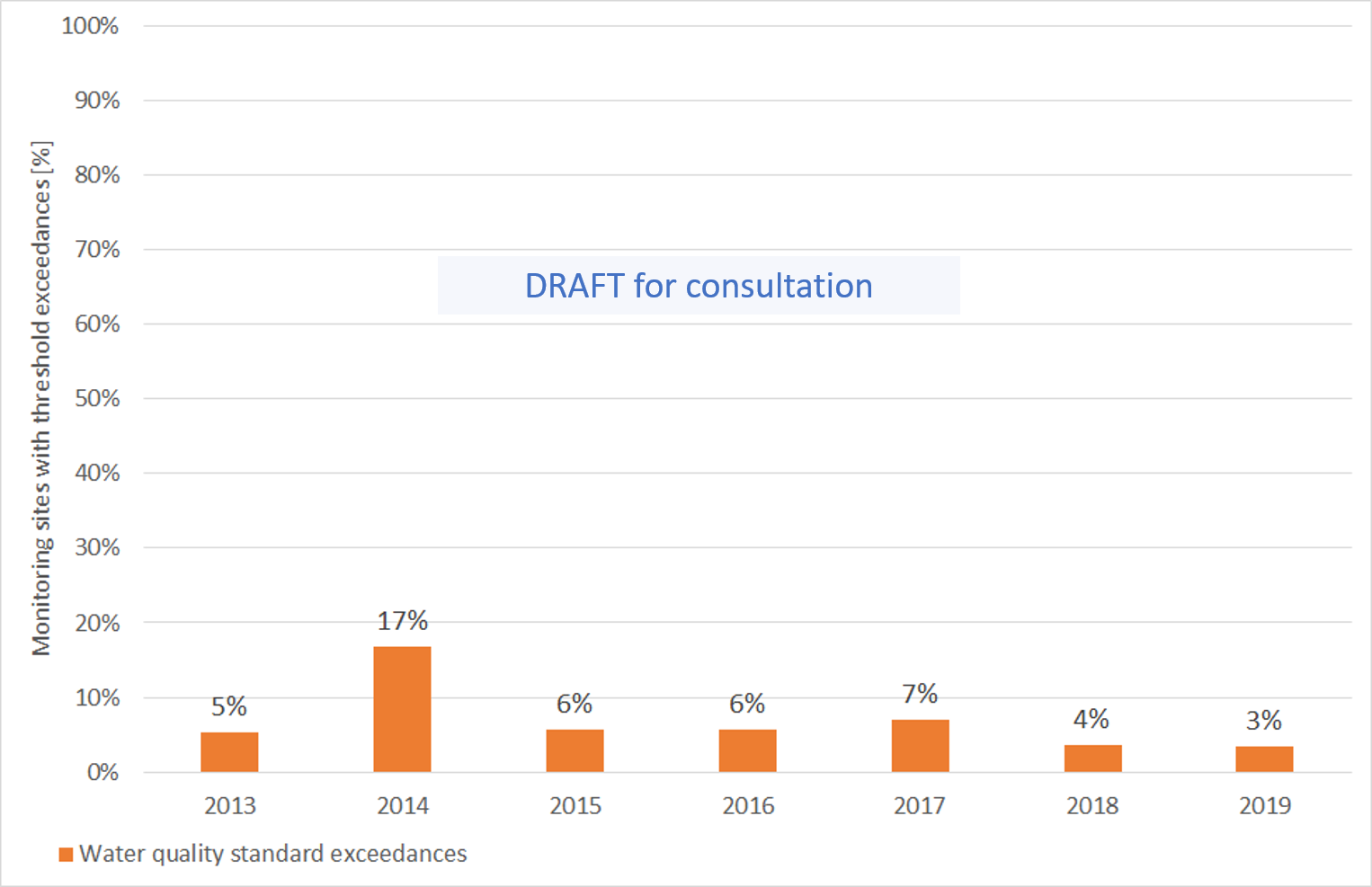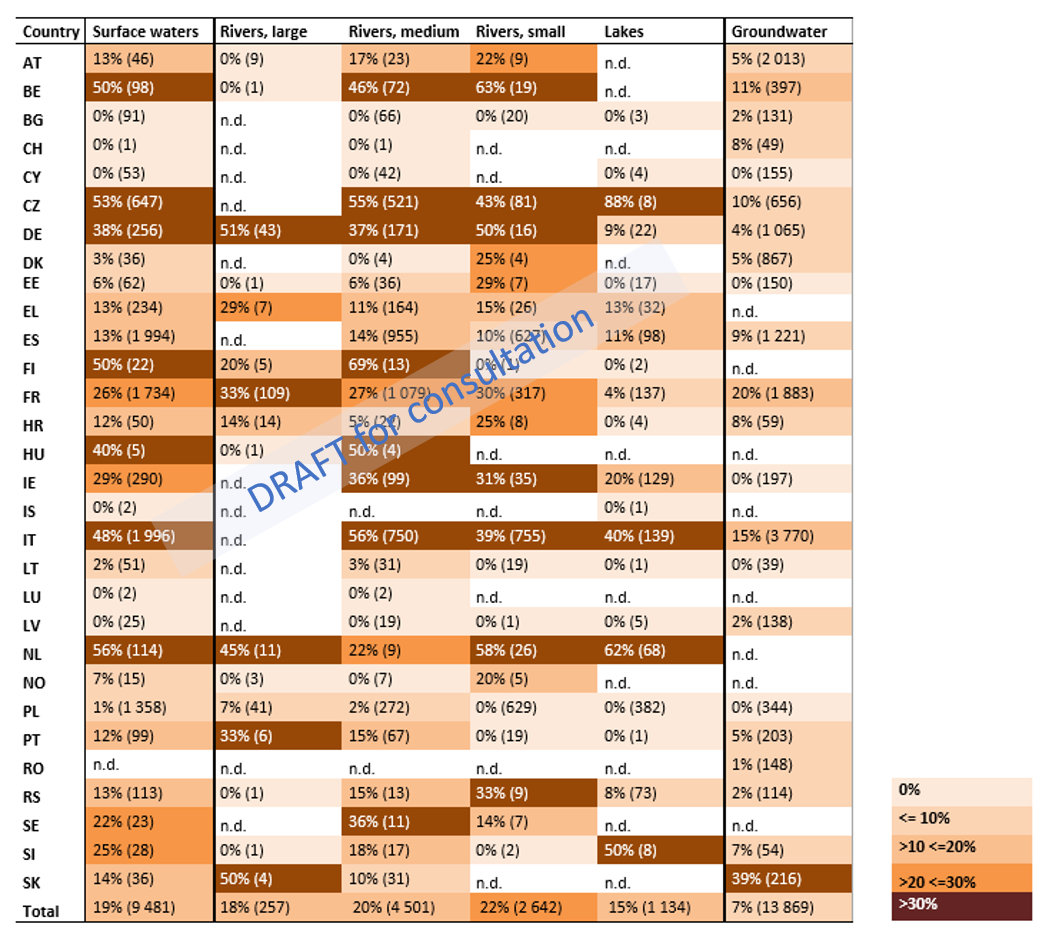Table of contents
1. Indicator Assessment: Pesticides in rivers, lakes and groundwater in Europe
Key messages
- Pesticides in surface and groundwaters are relevant to environmental quality, chemicals strategy for sustainability, Zero Pollution and agriculture assessments.
- This indicator focuses on pesticides[1] in rivers, lakes and groundwater based on measured concentrations[2] assessed against effect thresholds.
- 13 to 34% of all surface water monitoring sites showed threshold exceedances of pesticides in surface waters between 2013 to 2019. This was mainly caused by the insecticides imidacloprid and malathion, and the herbicides MCPA, metolachlor and metazachlor. These substances were approved for use in plant protection products during the monitoring period.
- The percentage of pesticides exceeding the groundwater quality standard was lower, at 3 to 17% of monitoring sites. In groundwater, exceedances were mainly caused by the herbicide atrazine and its metabolites. Atrazine was not approved for use in plant protection products during the monitoring period.
- Exceedance rates higher than 30% occurred in 15 out of 30 countries in surface waters, and in one out of 22 countries in groundwater. High exceedance rates were mainly related to monitoring sites in small and medium-sized rivers.
- No trends can be derived at this time, owing to e.g. variation in losses from the application of pesticides between years, or variation in the frequency of monitoring of pesticides in surface waters. For these reasons, between-year changes may not be significant.
[1] Pesticides include both active substances from plant protection products and biocides as well as their relevant metabolites.
[2] Data source: EEA Waterbase - Water Quality
Fig 1 Percentage of monitoring sites with threshold exceedances in surface waters and groundwater in Europe
a) Surface waters

b) Groundwater

Note:
The figures show the percentage of monitoring sites with exceedance of effect thresholds or quality standard, set by European or national regulatory standards, with a country weighting factor to reduce the impact of uneven data reporting:
∑ Percentage of monitoring sites with exceedances per country [%] x country area [km²]
∑ Area of countries with reported monitoring sites per year [km²]
For surface waters, European environmental quality standards and (in absence of those) national regulatory standards were used, reflecting the lowest ecotoxicologically-based effect threshold. Effect thresholds were identified for 114 out of 217 pesticides (53%). Exceedances included here refer to these 114 pesticides.
For groundwater, the Groundwater Directive quality standard of 0.1µg/l was used to identify exceedance. 12 non-relevant metabolites (nrM) were excluded from the assessment. Further information on methods of indicator development can be found in the supporting information for the indicator.
Fig. 2 Percentage of monitoring sites with threshold exceedances of pesticides in surface waters, different sized rivers, lakes and groundwater in European countries, 2013 – 2019.

Note:
n.d. = No data; In brackets: Total number of reported monitoring sites.
The percentage of exceedance rates was calculated based on the number of reported monitoring sites with exceedances, divided by the total number of reported monitoring sites. River size could not be assigned to all monitoring sites (so total surface waters does not equal the sum of lakes plus large, medium and small rivers). This issue mainly affects Italy and Spain.
Pesticides differ from many other pollutants as they are designed to harm organisms (e.g. plants, insects, fungi) and thus inevitably have an effect on the environment. When concentrations of pesticides are above critical thresholds, individually or as mixtures, they can be harmful to the environment and /or humans by contaminating soil, surface waters and groundwater. Pesticide contamination of both surface waters and groundwater can affect aquatic fauna and flora, but also human health if, for instance, water or fish contaminated by pesticides is consumed.
According to Water Framework Directive (WFD) (EC, 2000) pesticide pollution above critical thresholds leads to both failure of ‘good chemical status’ in surface waters based on pesticide substances listed as priority substances, and failure of ‘good ecological status’ based on pesticide substances listed as river basin specific pollutants. This directly affects the failure of the environmental objectives of the WFD as well as the goal of the new Biodiversity Strategy to implement and enforce the WFD objectives to be met by 2027.
Within the WFD, pesticides are also listed as groundwater pollutants to assess the chemical status of groundwaters. For each specific pesticide substance, a quality standard of 0.1µg/l was set in the Groundwater Directive (EU, 2006).
Within actions of the Green Deal, the EU set targets for the reduction of the use and risk of pesticides by 50% and a 50% reduction in more hazardous pesticides until 2030 in the Zero Pollution Action Plan (EC, 2021), the Farm to Fork Strategy (EC, 2020a) as well as the Biodiversity Strategy (EC, 2020b) with a focus to improve and protect ecosystems and biodiversity. The indicator is based on ecotoxicological effect thresholds defined for aquatic systems and thus addresses the targets of all the directives and strategies mentioned above.
The indicators are in line with the one-out-all-out-principle of the WFD: If one substance exceeds effect threshold value (in surface water) or quality standard (in groundwater) the monitoring site is classified as ‘Threshold exceedance’ or ‘Quality standard exceedance’.
Between 2013 to 2019, pesticide concentrations were reported from a total of 9 481 monitoring sites for surface waters and 13 869 for groundwater. The number of reported monitoring sites in surface waters varies between countries from less than 10 sites (CH, HU, IS, LU) to more than 1 000 sites (ES, FR, IT, PL). This variation also occurs in groundwaters, with numbers ranging from 39 sites (LT) to more than 3 000 sites in IT (and more than 1 000 sites in AT, DE, ES, and FR).
The number of reported pesticide substances in surface waters ranges from less than 10 substances (CH, DK, HU, IS, LU, NO) to more than 100 substances (CZ, DE, FR, IT). For groundwater, the lowest reported number of substances was reported from AT (6) and highest number from FR (226).
Pesticides most often causing exceedance in surface waters are the insecticides imidacloprid and malathion, and the herbicides MCPA, metolachlor and metazachlor. These substances were approved for use in plant protection products during the monitoring period. In groundwater the herbicide atrazine and its metabolites cause the most exceedances. Atrazine was not approved for use in plant protection products during the monitoring period.
It is not yet possible to determine a trend in Figure 1. Losses from the application of pesticides may vary considerably between years depending upon e.g. crop type and the weather (EC, 2008), and the frequency of monitoring of pesticides in surface waters can be limited to one year out of three. For these reasons, changes between years may not be significant. It is anticipated that a trend will become apparent in the next few years.
Fig. 1 shows the percentage of monitoring sites with threshold exceedances in surface waters and groundwater. In surface waters, the peak in 2017 is driven by an exceedance rate in Spain ten times more than compared to other years. In groundwater, the peak in 2014 is driven by an exceedance rate in Italy ten times more than other years, and in Slovakia three times more.
Fig. 2 shows the percentage of monitoring sites with threshold exceedances of pesticides in surface waters, different sized rivers, lakes and groundwater in European countries. This was used to examine threshold exceedances according to Surface Waters; Rivers, small; Rivers, medium; Rivers, large; Lakes, and Groundwater. Exceedance rates higher than 30% occurred in 15 out of 30 countries in surface waters, and in one out 24 countries in groundwater. High exceedance rates were mainly related to monitoring sites in small and medium-sized rivers.


